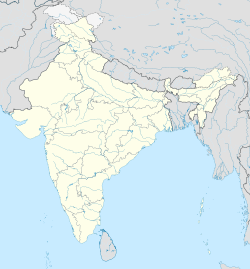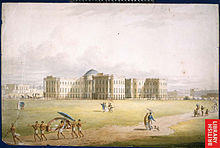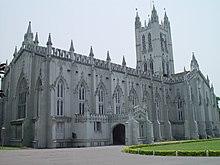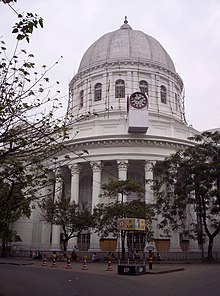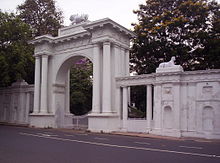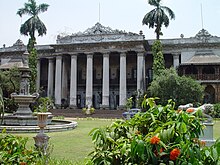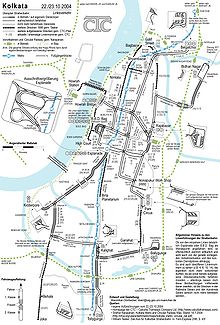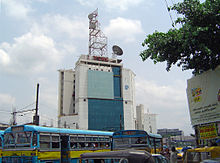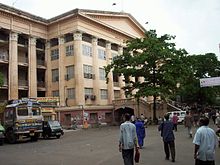Calcutta
| Calcutta | ||
|---|---|---|
|
|
||
| State : |
|
|
| State : | West Bengal | |
| District : | Kolkata | |
| Location : | 22 ° 34 ′ N , 88 ° 22 ′ E | |
| Height : | 6 m | |
| Area : | 206.08 km² | |
|
Inhabitants : - Agglomeration : |
4,486,679 (2011) 14,112,536 (2011) |
|
| Population density : | 21,772 inhabitants / km² | |
| Postal code : | 700001 - 700141 | |
| Website : | http://www.kmcgov.in/ | |
| Victoria Memorial | ||
Calcutta , officially Kolkata ( Bengali কলকাতা , IAST : Kalkātā ; English until 2001 Calcutta ), is the capital of the state of West Bengal in India . With 4.5 million inhabitants, Calcutta is the seventh largest city in India, and with 14.1 million inhabitants in the metropolitan region of Calcutta (2011 census) the third largest metropolitan area in the country.
With the establishment of a British East India Company base in 1690, Calcutta became a center of British possession in India. Calcutta was the capital of British India until 1911 . Today Calcutta is an industrial city, transport hub and cultural center with universities, theaters, cinemas, museums and galleries. The Kalighat Temple in honor of the goddess Kali (called Kalika here) makes the city one of the most important Hindu pilgrimage sites.
name of the city
In the local Bengali language, the name is কলকাতা Kalkātā [ ˈkolkat̪a ]. During the British colonial period, the city received the English form of the name Calcutta [ kælˈkʌtə ]. The spelling of the German name Calcutta [ kalˈkʊta ] is based on English (only the C s were Germanised to K s), but its pronunciation does not correspond to either the English or the Bengali form.
In 2001, the city's English name was officially changed to Kolkata , corresponding to the Bengali name. Like the renaming of Bombay in Mumbai and Madras in Chennai in the 1990s, Calcutta's name change reflects anti-colonial and regionalist sentiments in Indian politics. The new form of the name Kolkata was adopted into official language in Austria and Switzerland. In some cases it has also become naturalized in Germany.
geography
Geographical location
Calcutta is located in the state of West Bengal on the Hugli River , an estuary in the western Ganges Delta , an average of six meters above sea level . The urban area has an area of 187.33 square kilometers. The Kolkata Metropolitan Area (KMA) covers 1,854 square kilometers. In addition to the megacities of Calcutta and Haora and the large city of Chandannagar , the region also includes a further 38 municipalities and 72 cities.
The city of Calcutta has developed into the largest metropolitan area in West Bengal. Almost the entire jute processing industry in the Middle East was concentrated in it. The jute itself since the end of the 19th century, especially in the extremely densely populated East Bengal (now Bangladesh grown reinforced) and now forms one of the main products of the area.
The division of India separated the cultivation areas in Bangladesh from the processing plants in India. This led to Bangladesh building up its own jute industry. In addition, the Hugli increasingly silted up. Calcutta has thus increasingly lost its historical role as an important trading port.
ecology
The air pollution in Calcutta has reached enormous proportions. The high content of fine dust is the biggest problem. The causes lie in factories, small industries, power plants and traffic as well as in private households. The emission of carbon dioxide is increasing rapidly as a result of advancing industrialization and a steadily growing volume of traffic and energy consumption. The inadequate technical systems in the factories repeatedly lead to impairments.
Problems are also caused by the pollution of the groundwater due to the lack of sewage treatment plants, unregulated waste dumps, the pollution of the Hugli and the traffic noise. Only about half of the inhabitants in the slums on the outskirts of the city are connected to a water supply network, the other part use hydrants on the street or contaminated canals and rivulets.
In addition to infectious diseases such as diarrhea , dysentery and cholera , which are spread due to inadequate hygienic conditions, there are respiratory and skin diseases due to the toxic emissions of many industrial plants and motor vehicle traffic. Particular problems arise from the often direct neighborhood of poorer residential areas and industry. Air pollution and the urban sprawl of historically significant areas destroy many of Calcutta's cultural monuments.
climate
The short winter time is the most pleasant climate , when the daily maximum temperature is 27 degrees Celsius, shortly before the start of the monsoon season, the heat weighs heavily on the city.
The onset of rains at the end of June bring the longed-for relief, but the heavy floods also turn the streets into mud. In 1978, 15,000 people died in floods caused by heavy monsoon rains in Calcutta. On September 27, 1978, the highest amount of precipitation in history was measured at 380 millimeters in one day. October and November are pleasant months after a brief period of heat after the monsoons. Durga Puja , the city's biggest festival, is then celebrated.
The average annual temperature is 26.9 degrees Celsius, and the annual rainfall averages 1,614 millimeters. The warmest month is May with an average of 30.8 degrees Celsius, the coldest is January with an average of 20.1 degrees Celsius. Most of the precipitation falls in July with an average of 385 millimeters, the least in December with an average of 13 millimeters.
The city is also endangered by recurring cyclones . The storms brew over the Indian Ocean north of the equator, especially in the summer months, and then drift north towards India. The main danger in the coastal regions comes from the tidal waves that are sometimes more than ten meters high and push violent cyclones in front of them. On October 7, 1737, one of the worst storms caused around 300,000 lives at the mouth of the Hugli.
| Calcutta | ||||||||||||||||||||||||||||||||||||||||||||||||
|---|---|---|---|---|---|---|---|---|---|---|---|---|---|---|---|---|---|---|---|---|---|---|---|---|---|---|---|---|---|---|---|---|---|---|---|---|---|---|---|---|---|---|---|---|---|---|---|---|
| Climate diagram | ||||||||||||||||||||||||||||||||||||||||||||||||
| ||||||||||||||||||||||||||||||||||||||||||||||||
|
Average monthly temperatures and rainfall for Calcutta
Source: WMO ; wetterkontor.de
|
|||||||||||||||||||||||||||||||||||||||||||||||||||||||||||||||||||||||||||||||||||||||||||||||||||||||||||||||||||||||||||||||||||||||||||||||||||||||||||||||||||||||||||||||||||||||||||||||||||
history
origin
The name of the city is derived from the fishing village Kalikata , which was first mentioned in 1495 by the Bengali poet Bipradas Pipilai. The name means "black gate" or "gate of the goddess Kali ". In 1596 the historian Abul Fazl (1551-1602) reported in his work "Ain-i-Akabari" about the place.
When the Briton Job Charnock (1630–1692), director of the British East India Company , founded the company's headquarters in Sutanuti on the east bank of the Hugli on August 24, 1690 , the river bank was already lined with trading posts from other European countries. In addition to the British, whose base was previously in the village of Hugli on the west bank, the French had settled in Chandannagar , Dutch and Armenians in Chunchura , Danes in Serampore , Portuguese in Bandel , Greeks in Rishra and Germans in Bhadreswar . Nevertheless, the British with Charnock boasted for a long time that the city was founded.
With Armenian financial support, the East India Company bought land around Sutanuti and completed its first fortress in the region in 1699, named Fort William, after the King of England and Scotland , William III. (1650-1702). Only a few years later the East India Company merged Sutanuti and two other villages to form the city of Calcutta. In 1715 a delegation at the Mughal Court in Delhi negotiated further trading rights and the takeover of several villages and towns on both banks of the Hugli.
Rise and flowering period
On June 19, 1756, the Nawab of Murshidabad , Siraj-ud-Daula (1733-1757) conquered the city and the fort, which was not until a year later, on June 23, 1757, after the Battle of Plassey by the reconquest under Robert Clive , 1st Baron Clive (1725–1774) returned to the East India Company.
After the parliament in London recognized the trade monopoly of the company in 1773, the capital of Bengal moved from Murshidabad to Calcutta. In 1781, today's Fort William was completed, which never had to be defended. From then on, Calcutta was a trading center for many branches of trade, including the lucrative opium export to China. The East India Company brought British bachelors into the country and made them civil servants. The so-called writers ("Schreiber") lived under spartan circumstances in simple mud huts until they could move into the Writers Building specially built for them . The young men adapted to the local way of life and married Indian women. A new Euro-Asian society was born.
When Parliament lifted the East India Company's monopoly after the Sepoy Uprising and opened the doors of trade, numerous merchants and adventurers from all over the world arrived, including Parsees, Jews from Baghdad , Afghans and Indians from other parts of the country. Magnificent buildings such as Court House , Government House and St Paul's Cathedral earned Calcutta the name "City of Palaces" in the 19th century , but the uncomfortable humid climate, the musty salt marshes and the shabby huts that were built around the city, caused unsanitary conditions and were a source of poverty and disease.
The city's wealthy elite, which included Bengali merchants, were given the label bhadra lok , the "good people". Rudyard Kipling , the author of the jungle book , distorted this designation in his depiction of the bandar lok ("ape-men"). This very layer was responsible for the cultural bloom of the 19th century, known as the Bengali Renaissance .
Until 1911 Calcutta was the capital of the colony of British India and the seat of the Governor General of the East India Company, who from 1858 also held the newly created office of British Viceroy . In 1813 a bishopric was also established.
Consolidation
Calcutta's importance as an international port waned with the opening of the Suez Canal in 1869, the rise of Mumbai and the end of the opium trade. In 1911 the glorious time came to an end when India's capital was relocated to Delhi. Calcutta has been the capital of the state of West Bengal since August 15, 1947, India's independence day .
Since then, after civil unrest and uprisings , the urban infrastructure has repeatedly been strained to the limit by mass immigration of dispossessed refugees. The resulting grievances and also the work of Mother Teresa , who drew the world's attention to the victims, have given Calcutta the reputation of a poor house that the city dwellers themselves do not consider to be justified.
When India's first subway opened in 1984 , there was talk of a new economic start. However, over the years the city has not matched the growth of emerging economic centers in other parts of the country such as Hyderabad or Bangalore .
population
Population structure
According to the 2011 census, Calcutta has 4,486,679 inhabitants. This makes Calcutta the seventh largest city in India after Mumbai , Delhi , Bangalore , Hyderabad , Ahmedabad and Chennai . The population density is very high with around 24,000 inhabitants per square kilometer (for comparison: New York City approx. 10,500 people / km² , Berlin approx. 3,900 people / km² ). According to the census, 14,112,536 people live in the agglomeration of Calcutta, which has meanwhile grown well beyond the administrative city limits. If you take the population of the agglomeration as a basis for assessment, Kolkata is the third largest city in India after Mumbai and Delhi.
Since the beginning of colonial development, Calcutta has experienced immigration not only from the neighboring hinterland, but from all over India and the neighboring states, in accordance with the international and supraregional importance of the city. The result is a conglomerate of people of different ethnic and linguistic backgrounds. The overwhelming number of residents are Bengal, plus minorities from Bihari, Marwari, Chinese, Tamils , English, Armenians , Tibetans , Marathas and Parsees . The most widely spoken languages are Bengali , Hindi , English , Urdu and Bhojpuri .
The literacy rate in Calcutta is 80.9% (men 83.8%, women 77.3%), well above the average for India (74.0%) and West Bengal (68.6%), but corresponds to the average for the urban population.
Population development
From 12,000 inhabitants in 1710, Calcutta's population rose to 187,000 by 1831 and hit the one million mark around 1930. By 1941 this number doubled to two million, then again to over four million by 1991. Due to the narrow city limits, the population increase has now significantly weakened, this is mainly taking place in the countless suburbs. Between 2001 and 2011, the number of inhabitants in the city proper even fell slightly for the first time; in the same period, the population of the Calcutta agglomeration grew by 10% to over 14 million. For 2050, a population of 33 million people is expected in the agglomeration.
The following overview shows the number of inhabitants according to the respective territorial status. Up to 1839 these are estimates, from 1872 to 2011 they are census results. The population figures refer to the actual city without the suburbs.
|
|
Living situation
The city center is dominated by two- to three-storey buildings with flat roofs (Pucca houses). Bricks, metal or asbestos panels, stone and concrete are usually used as building materials. Calcutta's upper class lives in the more modern buildings, the concrete apartments (mostly with verandas). The greatest density of high-rise buildings with heights between 56 and 91 meters can be found on JL Nehru Road and its surroundings. On the outskirts there are huts made of grass, leaves, bamboo, clay, wood or earth (Kutcha huts). According to the 2001 census, one third of the population (1.5 million people) lived in the 2,011 registered and 3,500 unregistered slums .
The construction material shows that many Pucca and Kutcha houses offer insufficient protection against the elements and the penetration of pests . The use of asbestos sheets releases dangerous fibers which, if inhaled , can lead to lung cancer and asbestosis , for example. The problems of the metropolis of Calcutta are particularly evident in the slums. Malnutrition, hunger, inadequate disposal and inadequate water supply lead to increased infant mortality and the outbreak of tuberculosis , leprosy and malaria , social effects - crime, prostitution , alcoholism - also grow under such framework conditions.
In a ranking of cities according to their quality of life, Calcutta ranked 160th out of 231 cities worldwide in 2018. The city was behind Hyderabad (place 142), Bangalore (place 149) and Mumbai (place 154) but still ahead of Delhi (place 162).
Religions
According to the 2001 census, religious affiliation is distributed as follows: 77.68% of the population are Hindus , 20.27% Muslim and 0.88% Christian . The rest is divided between Jainas , Sikhs , Buddhists , Jews and Parsees .
| population | Percentage ownership % | |
|---|---|---|
| Hindus | 3,552,274 | 77.68 |
| Muslims | 926,769 | 20.27 |
| Christians | 40,218 | 0.88 |
| Jainas | 20,859 | 0.46 |
| Sikhs | 15,599 | 0.34 |
| Buddhists | 6,445 | 0.14 |
| Other | 2,179 | 0.05 |
| No information | 8,533 | 0.19 |
| total | 4,572,876 | 100.00 |
Source: Census of India 2001
Politics and administration
According to the Indian constitution, a local administration for larger urban areas is organized in the form of a municipal corporation.
City structure
The Kolkata Municipal Corporation is divided into 16 boroughs (Boroughs I to XVI) and these into 144 districts (Wards). The urban agglomeration extends over the following areas:
- Old Kolkata:
- Sutanuti - Chitpur, Baghbazar, Sobhabazar, Hatkhola
- Kolkata - Dharmatala, Bowbazar, Simla, Janbazar
- Gobindapur - Hastings, Maidan, Bhowanipur
- New Kolkata:
- North - Sinthi, Cossipore, Gughudanga
- South - Tollygunge, Kidderpore, Behala
- East - Salt Lake, Beliaghata, Topsia
- West - Hooghly river
- Greater Kolkata:
- East - Kalyani to Budge Budge
- West - Baruipur to Bansberia
City government
Sovan Chatterjee of the Trinamul Congress has been Mayor of Calcutta since 2010 . From 2005 to 2010 Bikash Bhattacharya was the mayor of Calcutta. Bhattacharya is a member of the Communist Party of India (Marxist) and chaired the Standing Committee of the Kolkata Municipal Corporation. The latter is responsible for maintaining and expanding the urban infrastructure.
In the past, the CPI (M) and its partners have succeeded in significantly advancing agricultural reform in West Bengal and in installing social security systems. The policy, which is oriented towards the needs of the broad masses of the people, has given the party a permanently high potential for support. Other influential parties in Calcutta are the Indian National Congress and the Trinamul Congress .
The Calcutta High Court in Calcutta is the highest legal instance for the state of West Bengal and the union territory of the Andaman and Nicobar Islands .
Town twinning
Calcutta has partnerships with the following cities:
-
 Karachi ( Pakistan )
Karachi ( Pakistan ) -
 Kunming - date unknown - and Guangzhou - 2007, ( People's Republic of China )
Kunming - date unknown - and Guangzhou - 2007, ( People's Republic of China ) -
 Long Beach ( USA )
Long Beach ( USA ) -
 Naples ( Italy ) - date unknown
Naples ( Italy ) - date unknown -
 Odessa ( Ukraine ) - probably since the 1980s
Odessa ( Ukraine ) - probably since the 1980s -
 Incheon ( South Korea ) - 2007
Incheon ( South Korea ) - 2007
Culture and sights
overview
Calcutta is the center of Indian intellectuals and the artistic avant-garde . The Nobel Prize for Literature in 1913 Rabindranath Thakur (1861–1941) worked here, as did Mother Teresa (1910–1997), who is probably the most famous citizen of the city in the West. In 1979 she received the Nobel Peace Prize for her work . The Indian physicist Satyendranath Bose also lived here.
The Indian national library, museums and a lively theater, music and film scene ( Kolkata Film Festival ) are further examples of the importance of art and culture in the city. There are several universities that are doing intensive research. Many colorful festivals and a lively religious life are significant for Calcutta with its important Kali temple, Kalighat .
Theater and film
Calcutta's art scene is famous for its vibrant theater culture. Music, dance and theater are performed at several non-religious annual festivals, for example on the occasion of Ganga Utsav , which takes place at Diamond Harbor for a few weeks from the end of January .
The Rabindra Sadan theater and concert hall in Kolkata offers upscale culture, while Nandan on neighboring AJC Bose Road is the city's premier cinema. Founded by Calcutta's famous filmmaker Satyajit Ray , the Nadan Film Center houses an archive, library and projection room.
Museums
Founded in 1814 and located at the intersection of Chowringhee Road and Sudder Street, the Indian Museum is the oldest and largest in the country. The current building with high ceilings around a central courtyard was opened in 1878 and, as one of the largest museums in Asia, exhibits a wide range of exhibits - from sculptures to natural history objects.
You can see a collection of stone and metal sculptures, the center of which is a magnificent sandstone lion capital from the 3rd century BC. Chr. Stands. One department exhibits remains of the Buddhist stupa from Bharhut in Madhya Pradesh from the 2nd century BC. Chr. From. Other exhibits include stone sculptures from Khajuraho as well as pictures by the Company School , a group of 19th-century Indian artists who used Western techniques and themes for European patrons.
The Calcutta Gallery at the southern end of the Maidan is dedicated to the Indian people of Calcutta and the struggle for independence. The evening Sound and Light Show has the same theme. The small Ashutosh Museum of Indian History in the Centenary Building on College Street has a collection of Bengali art, craft exhibits, fabrics, and rare Buddhist manuscripts and statues.
Immediately to the north of St. Paul's Cathedral, the Birla Planetarium , the largest in Asia and one of the largest in the world, offers several daily screenings. To the south of the cathedral, the Academy of Fine Arts on Cathedral Road presents contemporary Bengali art. In addition to traveling exhibitions, it offers permanent exhibitions on works by artists such as Jamini Roy and Rabindranath Thakur . A café and green spaces add to the ambience. The large Rabinda Sadan lecture hall regularly has classical music on the program.
Buildings
BBD bag
The economic and administrative center of Calcutta is BBD Bag (also Anglicized: BBD Bagh ), which locals still call Dalhousie Square . The new official name commemorates three revolutionaries, Benoy Basu, Badal Gupta and Dinesh Gupta, who shot the Inspector General of Prisons, Colonel NS Simpson, on the balcony of the Writers' Building on December 8, 1930. The former name Dalhousie Square refers to the Governor General of British India , Lord Dalhousie . He ruled from 1847 to 1856. In the center of the square is the large Lal Dighi water basin .
In 1868, built on the site of the former Fort William main post office (General Post Office) to the west of the square hides allegedly behind its walls the notorious Black Hole of Calcutta . On a hot June night in 1756, the henchmen of Sultan Siraj-ud-Daula crammed 146 English prisoners into a small chamber that was only ventilated through tiny window slits. The next morning most of them were suffocated. The guards had not recognized the looming tragedy, and Siraj-ud-Daula was taken aback when the news reached him. When Robert Clive regained power over Calcutta, he had the fort, which was destroyed by Siraj-ud-Daula in 1756, rebuilt at its current location on the Maidan.
To the north of the square, the Writers' Building was built in 1780 and is now the official seat of the West Bengal government. The writers of the British East India Company were housed in the original building . A symbol of Calcutta's Scottish tradition is the gray tip of St Andrew's Kirk , which rises northeast of the BBD Bag. The Scottish Church was established in 1818 despite strong opposition from the Anglican community .
Further to the east, on the oldest street in town - the former Mission Row and today's RN Mukherjee Road - is the Old Mission Church, founded in 1770 by the Swedish missionary Jahann Kiernander . The St John's Church south of the main post office goes back to the year 1787th Inside, next to memorial plaques to British residents and the first bishop of Calcutta, Bishop Middleton, hangs a Last Supper painting by Johann Zoffany, on which prominent citizens of the city are depicted as apostles . The oldest cemetery in the city also houses the grave of Job Charnock, the founder of the British trading post in Calcutta.
The area south of the square is dominated by the Government House . The building overlooks the north of the Maidan and the boulevard Red Road, which once served as an airstrip and is now the city's only main thoroughfare without potholes. The building served as the residence of the British Governors General and Viceroys until 1911; today it is the official address of the Governor of Bengal under the name Raj Bhavan . When it was built in the late 18th century, a palace modeled on the mansion of Kedleston Hall in Derbyshire , England, was to be created. The house, which is sealed off from the rest of the city by a high iron fence, can be entered through four magnificent gates. In addition to the former throne room of George V (1865–1936) and an imposing ballroom with chandeliers, you can also admire Calcutta's first elevator, which still works today. To spread over the land trophies include a bronze cannon on a winged dragon, during the Opium Wars in Nanjing ( China was conquered) and brass cannons from the Afghanistan -Feldzügen.
Fort William
To the gates of Fort William, a street leads west through the park of the Maidan from the end of Park Street. Only certain areas of Fort William are open to the public on special occasions as the fort serves as the military headquarters of Eastern Command .
The fortress was commissioned on the site of the old village of Gobindapur after the British defeat of 1756, completed in 1781 and named after King William III. (1650-1702) named. The distorted octagon with a diameter of around 500 meters has massive, low defensive walls and six gates. Its facility should be able to accommodate the entire European community of the city in the event of an attack, but never had to be defended.
Victoria Memorial
Calcutta's pride and joy is the striking white marble Victoria Memorial at the southern end of the Maidan, with its formal gardens and watercourses. While other colonial buildings and statues have been renamed, attempts to rename the Victoria Memorial have so far failed. The popularity of Queen Victoria (1819–1901) (the monument is named after her) seems unbroken.
The extraordinary building with neo-Romanesque statues above the entrance, Mughal corner domes and elegant high colonnades on the sides was planned by the British Foreign Minister Lord George Nathaniel Curzon (1859–1925) to commemorate the Empire at its peak. It was designed by Sir William Emerson (1843–1924) and completed in 1921.
St. Paul's Cathedral
St. Paul's Cathedral , located near the Victoria Memorial, was built in 1847 under Major WN Forbes. The iron girder roof, measuring 75 by 24 meters, was the longest of its kind in the world at that time. For better ventilation, the pointed arched windows extend to skirting level, and large fans hang on the ceilings.
The stained glass window, which Sir Edward Burne-Jones (1833–1898) designed in 1880 in honor of the British Governor General Lord Mayo (1822–1872), stands out among many well-preserved memorabilia and memorial plaques for deceased imperialists . The original steeple was in 1897 by an earthquake destroyed, after another earthquake in 1934 it was the Bell Harry Tower of the Cathedral of Canterbury recreates.
Marble Palace
North of MG Road on Muktaram Babu Street, a side street off Chittaranjan Avenue, the Marble Palace (marble palace) presents its treasures. The imposing pillared mansion was built in 1835 by Raja Rajendro Mullick Bahadur, a wealthy zamindar (landowner). It testifies to the diverse influences to which its epoch was exposed. The descendants of the Raja still live in the palace, the name of which can be traced back to the richly decorated marble rooms.
They are decorated with statues, European antiques, Belgian glass, chandeliers, mirrors and Ming vases. The paintings include works by Peter Paul Rubens , Titian , Joshua Reynolds, and Thomas Gainsborough . Mention should also be made of a painting by Ravi Varna - a portrait of a woman whose eyes follow the viewer everywhere - as well as a depiction of five galloping horses that seem to change direction as you walk past them.
Kalighat
Calcutta's main temple, Kalighat ( three miles south of Park Street) is in the center of a densely populated area. The simple, typically Bengali temple with the curved roof shape was built in 1809 from bricks and mortar and is dedicated to the black goddess Kali , a Shakti shape.
According to legend, after the death of his wife Sati , Shiva went into a frenzy and began to dance with her dead body, so that the entire world shook. The gods tried to tame him in different ways, until finally Vishnu hurled his solar disc and cut the dead body into 51 pieces. Any place where one of these parts fell to the ground became pitha , a place of pilgrimage for worshipers of the feminine principle of divinity - Shakti. Kalighat Temple marks the place where her little toe fell on the ground.
Rabindra Setu
One of Calcutta's most famous trademarks is the Haora Bridge ( Howrah Bridge ), which connects the city with the twin city of Haora , located on the western bank of the Hugli . It is an 85 meter high and 670 meter long truss bridge that spans the river in a single span of 457.5 meters, making it one of the longest cantilever bridges in the world.
Her official name is Rabindra Setu . It was built in 1943 during World War II to give Allied troops access to the front in Burma, now Myanmar , and replaced an older pontoon bridge .
The Haora Bridge is considered to be the busiest bridge in the world because it is used by millions of commuters every day ; around 60,000 vehicles cross it every day.
Parks
The heart of the city is the “Maidan Park”, which attracts city dwellers of all walks of life to exhibitions and political gatherings, sport and idleness . The "Maidan" is one of the largest urban parks in the world. The origin of the park goes back to the year 1758, when the now rather inconspicuous Fort William was built near the river and the British officer, Lord Robert Clive (1725–1774), cleared wooded areas to create a free line of fire for his guns.
Today the residents do morning exercise there, riders gallop down the old paths and shepherds bring their herds to graze. Recreational athletes come together in the afternoons for spontaneous football and cricket games or for kabaddi competitions. Every January the Kolkata Book Fair , the largest book fair in the country, takes place here.
The "Botanical Garden" in Shibpur is ten kilometers south of the train station in Haora on the west bank of the Hugli . Only after the opening of the second Hugli Bridge did the townspeople rediscover the 109-hectare site, which was opened up in 1786 for the development of Indian teas. The garden is home to countless species of birds, including waders, cranes, and storks. The most famous attraction is the world's largest banyan tree , which is 24.5 meters high and has a circumference of 420 meters. Created in the mid-18th century, it survived the cyclones of 1864 and 1867, which, however, destroyed its main trunk. Its 1825 aerial roots fall down from the upper branch towards the ground and give the impression of a small forest. Elsewhere, palm trees line small lakes and ponds with pedestrian bridges. The palm house, the orchid house, the herbarium and the fern houses are also worth seeing .
Not far from the racecourse in Alipur (also called Alipore ) and opposite the luxurious Taj Bengal Hotel , the zoo has such rare creatures as Tigon (cross between tiger and lion), Litigon (cross between lion and Tigon ) or Litatitigon . The zoo also has white tigers from Rewa , a reptile house, an aquarium, a children's zoo and several restaurants.
Sports
Calcutta is the Indian soccer metropolis and is home to several top division clubs of the National Football League . The two big clubs Mohun Bagan Athletic Club and the East Bengal Club have been shaping Indian football since the 1930s. Both clubs play together with the Mohammedan Sporting Club in the Yuba Bharati Krirangan (also Salt Lake Stadium ), a football stadium for 120,000 spectators in the Bidhan Nagar district (also Salt Lake City ).
Calcutta is also a center of horse racing : the Calcutta Auction , developed by the Royal Calcutta Turf Club (RCTC), is a special form of sports betting that is very popular in the countries of the former British Empire and the USA. The Ranji Stadium , a world-famous cricket ground, can hold 100,000 spectators in Eden Gardens . Spectators occasionally riot here. The local cricket team are the Kolkata Knight Riders .
Regular events
Most of the concerts take place in winter and spring. Many of India's best musicians perform in late January / early February as part of the week-long Dover Lane Music Festival , held in a large tent in southern Calcutta. Other important cultural meeting places for one- and multi-day music events are Rabinda Sadan , AJC Bose Road / Cathedral Road, and Kala Bhavan , Theater Road.
In October there is the biggest festival that captivates the entire city, Durga Puja , the main festival in honor of the goddess Durga (another aspect of Kali). Statues are set up in all courtyards, streets and buildings in which the goddess is worshiped with great pomp for five days. Afterwards, people all over the city celebrate with music, dance and other cultural events. The traffic sometimes comes to a standstill.
The seven-day Kolkata Film Festival takes place in November . It attracts around 100,000 spectators and has no international competition. The festival has been held annually since 1995. However, there was an international film festival in Calcutta as early as 1952, which dates back to the founding of a film society in 1947. The city was also the first in India to have a permanent cinema in 1907. Calcutta has always been one of the centers of the Indian film industry , especially for films in the Bengali language .
gastronomy
Traditional Bengali cuisine, although Kolkata residents like to eat out, is limited to the domestic stove. The authentic Chinese and Muslim restaurants as well as the Tibetan cafes are popular. The west end of Park Street is the most diverse area for bars and restaurants .
Blue Fox and Moulin Rouge are sounding names that are reminiscent of the 1960s and 1970s, when the street was a small but very lively center for jazz, pop and cabaret . Some bars and restaurants still offer live music today. Western tourists who live in small hotels in the vicinity of Sudder Street are catered for by the local kitchens and cafes.
In New Market and Sudder Street in particular, the numerous street vendors sell the popular chai (black tea), where a spicy Indian breakfast and strong sweet tea in the mornings cost only a fraction of the restaurant prices. Behind New Market, several Muslim restaurants serve mostly meat dishes, but samosa (dumplings) are also available.
trade
In contrast to Delhi, Calcutta is not fixated on tourism - which, with a few exceptions, is clearly reflected in the shops. There are nevertheless many colorful markets, of which the extensive New Market and local institutions such as the Gariahat in the south in Baliganj (also called Ballygunge in Anglicising ) and Barabazaar in the north deserve a mention.
Modern shopping malls for books, clothing, leather goods and jewelry are spread across the city. They include Emami Shoppers City , Lord Sinha Road, the Metro Shopping Center at 1 Ho Chi Minh Sarani, and Shree Ram Arcade across from Lighthouse near the New Market. State emporia (department stores), many of which are located in the large Dakshinapan shopping complex south of Dhakuria Bridge near Gol Park, have a good selection of handicrafts.
Typical Bengali handicrafts include metalwork ( dokra ) from the area around Shantiniketan in the north-west of the city - objects made using the lost wax technique such as animal figures , birds or terracotta horses of all sizes from Bankura . Kantha fabrics have a fine linear embroidery pattern with decorative shapes, while Bengali leather goods have rather simple patterns and subtle colors.
Economy and Infrastructure
economy
According to a study from 2014, the Calcutta metropolitan area has a gross domestic product of 60.4 billion US dollars ( PPP ). In the ranking of the economically strongest metropolitan regions worldwide, it was 196th and third in India behind Delhi and Mumbai . The GDP per capita was US $ 4,036, making Calcutta the lowest per capita income of all 300 cities studied. GDP per capita rose by an average of 5.2 percent annually between 2000 and 2014. The city of Calcutta is responsible for a large part of the economic activity of the state of West Bengal.
The city's economic policy is based on the managed national economy , with the economy increasingly deregulated and privatized since 1991 . The informal sector accounts for 40 percent of the city's working population. The largest growth sectors are those through outsourcing , especially US companies, prospering areas of hardware and software production, call centers , as well as publishing and healthcare.
The technology sector recorded the greatest growth in 2005 with a growth rate of 70 percent. Numerous service jobs from all over the world have been relocated to Calcutta in recent years. The call centers already employ tens of thousands of people, and the number is rising. All the major national and international technology companies have large offices in the city.
Calcutta has a diverse manufacturing industry with jute , paper, chemical and petrochemical industries, shipbuilding and mechanical engineering. The city manufactures food, electronic and transportation equipment, cotton and silk textiles, steel and rubber products.
Major Indian corporations and banks have their headquarters in the city: ITC Limited , Bata India , Birla Corporation , Coal India Limited , United Bank of India , UCO Bank and Allahabad Bank . The country's second largest stock exchange, the Calcutta Stock Exchange (CSE), is also based in Calcutta.
Despite its reputation as India's “poor house”, the economy of the metropolis of Calcutta also offers opportunities for the poorest. In Mumbai, with its extensive urban slums, the associated problems are no less than in Calcutta, even if film adaptations such as that of the novel “City of Joy” leave a different impression.
traffic
Long-distance transport
Calcutta is the most important traffic junction in the region with roads , railway lines , intercity bus station , subway (until 2003 India's only subway system), port and international airport .
Located ten kilometers north of the city in Dum Dum, the airport was founded in 1924 and today has a national and an international part. It has been called Netaji Subhash Chandra Bose International Airport since 1995 , although the old name "Dum Dum International Airport" is better known. Calcutta has a good network of national flight connections and is connected to countries near and far by several international connections.
The port of Calcutta is the second most important in the country and is 120 kilometers from the coast.
Both of Calcutta's train stations do not yet have an underground connection, this is under construction. Howrah Station (হাওড়া স্টেসন) - the arrival point of the main trains from the south and west - is located a few kilometers west of the center on the other bank of the Hugli . The station Sealdah Station (শিয়ালদা স্টেসন), target of the trains from the north, is much cheaper on the eastern edge of the center, so no river crossing is necessary. There are prepaid taxi ranks at both train stations.
Calcutta is the gateway to Bangladesh . There are several flights from Calcutta to Dhaka with Bangladesh Biman Airlines and Indian Airlines . Direct train from Kolkata to Bangladesh does not exist, but trains from the station Sealdah until after Bongaon from where one with a motor rickshaw into five kilometers away Haridaspur and further reaches a rickshaw after Benapal at the border. Accommodation is available there. After an overnight stay, there is an eight-hour bus ride via Jessore to Dhaka.
Local transport
Almost all forms of public transport, including trams , buses , minibuses, taxis, and rickshaws , also add to the daily traffic chaos. Only the Kolkata Metro , the first subway in India, opened on October 24, 1984 , is a fast, clean and well-functioning means of transport. However, it only covers a distance of 16.5 kilometers and can therefore only relieve the traffic chaos little.
Calcutta's tram has hardly changed since the electrification of the route network in 1905 - it was commissioned as a horse-drawn tram on February 24, 1873. The tram, which runs on a 68-kilometer network, is the only one remaining in all of India.
Calcutta is the only city in India with human-drawn rickshaws . However, they are only available in the central urban areas, especially around New Market, where many rickshaw men supplement their low income in the pimp milieu. The rickshaws are particularly lucrative in the monsoons when the streets are waist-high and the rickshaw men can demand a fair amount of money for their efforts. Most of them are homeless Bihari who lead short and hard lives.
Motor rickshaws are rare in the city center. They are used as a shared taxi on certain routes and as a connection to the metro stations in suburbs such as Rashbehari or Gariahat. Cycle rickshaws have been banned from downtown and can only be found in the suburbs.
media
Print media
In addition to television, the print media play an extremely important role in everyday life in Calcutta and thus also in forming opinions. Newspapers and magazines are generally read more by men who have a formal higher education and a relatively high income. Important daily newspapers in Bengali are Anandabazar Patrika , Aajkaal , Bartaman and Sangbad Pratidin and Ganashakti . In English, Calcutta publishes The Telegraph , The Statesman , Asian Age , Hindustan Times and The Times of India .
broadcast
The city has six local FM radio stations: AIR Kolkata, Radio Mirchi (98.3 MHz), Red FM (93.5 MHz), Aamar FM (106.2 MHz), Gyan Vani (105.4 MHz), and Power FM (107.8 MHz). In addition, numerous other state and private radio stations can be received via VHF, cable and satellite. The radio market in Calcutta and all of India is currently in a state of upheaval due to the hesitant introduction of private broadcasting in 1993, its ban in 1998 and reintroduction in 1999. The radio landscape is changing permanently, more stations will be added and the use of radio will increase due to the wider offer.
watch TV
It was not until 1972 that All India Radio , now called Doordarshan , began broadcasting regular television programs in the former Calcutta - 13 years after television was introduced in the Delhi area . Color television and satellite programs have been around since 1982.
While around three quarters of the households in Calcutta now have terrestrial television reception, in rural areas it is only one third, satellite and cable television was initially reserved for the elite . Today the achievement mainly reaches the growing urban middle class and thus a wider population. The Indian state television Doordarshan broadcasts two terrestrial television channels in Calcutta. Furthermore, numerous cable and satellite channels can be received in Bengali, Hindi and English.
education
The city is home to numerous universities, colleges and technical schools, research institutes and libraries. The universities are: Bengal Engineering & Science University, Jadavpur University , Netaji Subhas Open University, Rabindra Bharati University, University of Calcutta , West Bengal University of Health Sciences, West Bengal National University of Juridical Sciences, West Bengal University of Animal and Fishery Sciences and West Bengal University of Technology.
Other important educational and research institutions are: Asiatic Society, Marine Engineering and Research Institute, Bethune College, Medical College Calcutta, Calcutta National Medical College, Center for Studies in Social Sciences, Indian Institute of Management, Indian Institute of Social Welfare and Business Management, Indian Statistical Institute, La Martiniere College, Maulana Azad College, National Library of India, Presidency College, Saha Institute of Nuclear Physics, School of Tropical Medicine, Scottish Church College, and St. Xavier's College.
Numerous state and a number of private schools provide general education for the population in Calcutta. Lessons are mostly in English or Bengali , some also in Hindi and Urdu . State schools are free of charge, but unattractive because of the overcrowded classrooms and poorly trained teachers. The private schools are chargeable and are therefore mostly reserved for the higher-income population. The latter can also be attended by obtaining a scholarship . While a good education is standard for the middle and upper classes of Calcutta, the poorer residents often fail because the children have to earn money to ensure the survival of their families and they cannot afford the prescribed uniform and school supplies can. Voice of World operates a boarding school and several schools for the blind and visually impaired in Calcutta.
The National Library of India is located in the former residence of the Lieutenant Governor of Bengal, Belvedere Estate, in Alipore. The first Governor General of British India, Warren Hastings, received the house from Mir Jafar, the commander of Siraj-ud-Daula's troops. When the capital was relocated to Delhi in 1911, the library stayed in Calcutta and today provides access to an extensive collection of books, numerous magazines, many reference works and rare documents that are protected in an air-conditioned room.
Calcutta is home to one of the six Goethe Institutes in India, which in this country are called Max Müller Bhavan after the German Indologist Friedrich Max Müller and see themselves as ambassadors of the German language and culture.
Personalities
sons and daughters of the town
- Nidhu Babu (1741–1839), poet and composer
- William Makepeace Thackeray (1811-1863), writer
- Rabindranath Thakur (1861–1941), Bengali national poet, Nobel Prize for Literature 1913
- Vivekananda (1863–1902), philosopher
- Chittaranjan Das (1870–1925), lawyer and politician
- Aurobindo Ghose (1872–1950), politician, philosopher and mystic
- Sunayani Devi (1875–1962), modern painter
- Margaret Ives Abbott (1876–1955), American golfer
- Neville Bulwer-Lytton, 3rd Earl of Lytton (1879–1951), British officer, sportsman and painter
- Prasanta Chandra Mahalanobis (1893–1972), physicist and poet
- Satyendranath Bose (1894–1974), physicist
- AC Bhaktivedanta Swami Prabhupada (1896–1977), translator and ISKCON founder
- Chhabi Biswas (1900–1962), actor
- Shaista Suhrawardy Ikramullah (1915–2000), politician in British Bengal and Pakistan
- Ion Calvocoressi (1919–2007), British officer and stockbroker
- Mike Hoare (1919-2020), Irish officer, mercenary and author
- Satyajit Ray (1921-1992), film director
- Hrishikesh Mukherjee (1922-2006), film director
- Tapan Sinha (1924–2009), film director
- Uttam Kumar (1926–1980), film actor
- Raj Bagri, Baron Bagri , CBE (1930–2017), British politician and entrepreneur
- John Mayer (1930-2004), composer and violinist
- Subrata Mitra (1930-2001), cameraman
- Dileep Kumar Kanjilal (* 1933), professor and indologist
- Shankar Ghosh (1935–2016), tabla player and composer
- Shashi Kapoor (1938-2017), actor
- Nabanita Dev Sen (1938-2019), author
- Pranab Bardhan (* 1939), economist
- Pam Crain (≈1939–2013), singer
- Gayatri Chakravorty Spivak (* 1942), literary scholar
- Aparna Sen (* 1945), film actress and film director
- Victor Banerjee (born 1946), actor
- Shuvaprasanna (* 1947), painter
- Sumantra Ghoshal (1948-2004), management scientist
- Altamas Kabir (1948-2017), lawyer; Chief Justice of the Supreme Court of India from 2012 to 2013
- Vikram Seth (* 1952), writer
- Sajal Karmakar (* 1955), musician (tabla)
- Amitav Ghosh (* 1956), writer
- Shujaat Khan (* 1960), sitar player
- Rajesh Mehta (* 1964), jazz musician
- Kiron Khosla (* 1967), painter
- Dhriti Banerjee (* 1970), zoologist
- Leander Paes (* 1973), tennis player
- Rani Mukerji (* 1978), actress
- Nipun Java , Indian poker player
- Aparna Balan (* 1986), badminton player
- Mary Ann Gomes (* 1989), chess player
Personalities who have worked on site
- Ishwar Chandra Vidyasagar (1820-1891), social reformer
- Mother Teresa (1910–1997), Catholic nun, Nobel Peace Prize 1979
- Ram Mohan Roy (1772–1833), reformer of religion and society
- Ramakrishna (1836–1886), Hindu mystic
- Rebecca Ryman (Asha Bhanjdeo) († 2003), writer
- Subhash Chandra Bose (1897–1945), politician and independence fighter
See also
literature
- Ravi Ahuja: Mumbai - Delhi - Kolkata. Approaches to the megacities of India . Draupadi-Verlag, Heidelberg 2006, ISBN 3-937603-07-7 .
- Hartmut Beck: Problem Spaces of the World, Volume 15, Calcutta . Aulis Verlag Deubner, Cologne 2002, ISBN 3-7614-1489-7 .
- Christian Feldmann: Mother Teresa. The saint of Calcutta . Herder, Freiburg 2000, ISBN 3-451-04855-8 .
- Bill Goodnow: A comparison of metropolitan areas in developing countries: Istanbul - Calcutta - Djakarta . Dietrich-Reimer-Verlag, Berlin 1992, ISBN 3-88091-581-4 .
- Martin Kämchen: Calcutta. A working anarchy . Wallstein, Göttingen 1994, ISBN 3-89244-081-6 .
- William D. Martin: Calcuttas changing face / The Changing Face in Calcutta. An Indian city from a social perspective . Tom-Laufersweiler-Verlag, Wettenberg 2000, ISBN 3-89687-913-8 .
- Peter Mosimann: Rickshaw Calcutta . U.-Bär-Verlag, Zurich 1988, ISBN 3-905137-17-8 .
- Horst Nusser, Siva Banerji, Usha Roti: Calcutta / City History / Colonial Foundation . Nusser-Verlag, Munich 1990, ISBN 3-88091-272-6 .
- Kurt Rosenthaler: Calcutta - poetry in chaos. Living in an impossible city . Verlag Ismero, Möhlin 2004, ISBN 3-033-00077-0 .
- Rainer Thielmann: Calcutta - Durga, poets and demons . Reiselyrik-Verlag, Halfing 2011, ISBN 978-3-9812583-2-5 .
- Ilija Trojanow / Anja Bohnhof: City of Books . LangenMüller, Munich 2012, ISBN 978-3-7844-3293-9 .
Web links
- Homepage of the City of Kolkata (English)
- City guide Calcuttaweb.com (English)
- FacingKalkutta - Portrait of a City (Weblog as part of a project by the Department of Journalism and Communication Studies at the University of Hamburg)
Individual evidence
- ^ Census of India 2011: Provisional Population Totals. Cities having population 1 lakh and above. (PDF file; 151 kB)
- ^ Census of India 2011: Provisional Population Totals. Urban Agglomerations / Cities having population 1 lakh and above. (PDF file; 138 kB)
- ^ Kolkata Municipal Corporation: About KMC - Basic Statistics
- ^ Kolkata Metropolitan Development Authority: Official website
- ^ The Telegraph - Calcutta: Downpour distress - Depression shows no sign of weakening, 170 mm of rain recorded in 12 hours
- ^ University of Cologne: The earthquakes off Sumatra ( Memento from January 10, 2007 in the Internet Archive )
- ^ The Tribune - Chandigarh: Job Charnock not Kolkata founder: HC says city has no foundation day
- ↑ Census of India 2011: Cities having population 1 lakh and above. (PDF file; 151 kB)
- ^ Census of India 2001: Urban Agglomerations / Cities having population 1 million and above .
- ^ Census of India 2011: Literates and Literacy rate by residence, Literacy rate by gender and Male-Female gap in literacy rates. (PDF file; 1.42 MB)
- ↑ World 101 largest Cities. Retrieved July 23, 2018 .
- ^ University College London: Understanding Slums - Case Studies for the Global Report 2003
- ↑ Mercer's 2018 Quality of Living Rankings. Retrieved August 18, 2018 .
- ↑ Census India Maps: ( page no longer available , search in web archives: 2001 census )
- ↑ THE CONSTITUTION (SEVENTY-FOURTH AMENDMENT) ACT, 1992 , Indian Constitution, accessed 2017-08-07.
- ↑ Kolkata Municipal Corporation: About Kolkata - Basic Statistics ( Memento of the original from May 16, 2008 in the Internet Archive ) Info: The archive link was automatically inserted and not yet checked. Please check the original and archive link according to the instructions and then remove this notice.
- ↑ HindustanTimes: Sovan Chatterjee to be new Kolkata mayor (English) ( Memento of the original from September 22, 2012 in the Internet Archive ) Info: The archive link was inserted automatically and has not yet been checked. Please check the original and archive link according to the instructions and then remove this notice.
- ↑ http://www.2point6billion.com/news/2007/12/14/kolkata-and-guangzhou-sister-cities-447.html
- ↑ http://www.telegraphindia.com/1051019/asp/calcutta/story_5370352.asp
- ↑ Online source ( Memento from November 6, 2011 in the Internet Archive )
- ↑ Indian Embassy in Seoul (English) ( Memento from March 31, 2010 in the Internet Archive )
- ^ Alan Berube, Jesus Leal Trujillo, Tao Ran, and Joseph Parilla: Global Metro Monitor . In: Brookings . January 22, 2015 ( brookings.edu [accessed July 19, 2018]).
- ^ The Telegraph - Calcutta: Nothing saved but face - Metropolitan Building roof still unprotected
- ^ The Telegraph - Calcutta: Retail returns to heritage edifice
- ^ The Goethals Indian Library & Research Society: Kolkata's Informal Sector
- ↑ BBC: Rising Kolkata's winners and losers
- ↑ Metro Railway, Kolkata: Official website ( Memento of the original from August 20, 2007 in the Internet Archive ) Info: The archive link was automatically inserted and not yet checked. Please check the original and archive link according to the instructions and then remove this notice.
- ^ Calcutta Tramways: Official website
